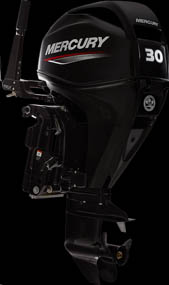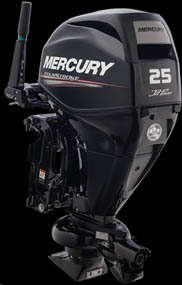What are the benefits of four-strokes over two-strokes?
Four-strokes have inherently cleaner running qualities over traditional two-strokes. They tend to have smooth and quiet operation, improved fuel efficiency, and don't smoke. These attributes provide consistent starting, better idle and trolling performance – and they reduce fuel consumption.
What is the advantage of EFI vs. carburetors?
Electronic Fuel Injection (EFI) technology provides precise metering of fuel to each cylinder, taking into account engine and ambient temperatures, atmospheric pressure, throttle position and boat load. The benefits include turn-key starting and smooth, trouble-free operation regardless of boating conditions.
What is "Battery-Free EFI" and why is this important?
Most EFI systems require a battery to operate correctly because the engine control unit (ECU) requires initial electric current for proper startup. During startup, the ECU "reads" ambient conditions and pressurizes the fuel system before the engine begins cranking. With battery-free EFI, the initial engine rotation charges the EFI electrical and fuel systems with a dedicated and separate electrical system under the flywheel. This eliminates the need for the battery. A second pull of the starter rope allows the system to start as if there was a battery connected.
This also allows the customer to realize the benefits of EFI on manual-start outboards. Often, customers purchasing manual-start outboards don’t want the added cost and weight of an electric-start system that includes a battery, but they do want the running quality that EFI delivers.
Why does my outboard have a recoil starter even though it is electric start?
There may be cases where the starting battery is drained from running a fish finder or electric trolling motor. When it’s time to start the main engine and go home, the electric starter may not turn the outboard over. If this happens, the outboard can be manually started by pulling on the manual recoil start handle. Most competitors require that you remove the cowl, flywheel cover and other parts of the outboard to gain access to the top of the flywheel to wrap the rope. With a Mercury FourStroke outboard, you just reach back and pull the rope.
I just bought a new four-stroke outboard to replace my old two-stroke. What should I know to properly service this new four-stroke?
The main items to service include checking and changing engine oil and proper lubrication as recommended by the Owner’s Manual.
What is a "ProKicker" and how does it compare to a standard model?
The 9.9 and 15 ProKicker (needs link) FourStrokes are outboards designed specifically as auxiliary trolling motors (often referred to as "kicker" motors). These unique outboards feature standard power tilt, high-thrust four-blade propellers, automatic self-centering straps (optional on remote-steer models) and unique decals designed to complement the main engine.
The 9.9 ProKicker also features a BigFoot gearcase which includes stronger gears, bearings and shafts as well as a low 2.42:1 gear ratio for improved low-speed handling and best-in-class slow trolling speeds.
What is the difference between "Power Tilt" and "Power Trim & Tilt"?
"Power Tilt" is designed to tilt the motor in and out of the water, or to a predetermined position prior to planing the boat. Although the power tilt system will hold the motor position at any engine RPM, it will generally not be able to tilt the outboard at engine speeds above 2000 RPM.
"Power Trim" is designed to trim the outboard at planing speeds for best optimum performance in addition to tilting the outboard in and out of the water. Power trim is available on outboards 25 horsepower and higher, as these applications are the most likely to benefit from this feature.
My outboard does not operate in the maximum RPM range shown in my Owner’s Manual. What should I do?
Mercury FourStroke outboards 20 horsepower and below come standard with a propeller that should meet the needs of most applications. However, there may be situations in which this standard propeller does not provide the best performance. In such cases, the propeller may need to be changed to a higher- or lower-pitch propeller. Generally speaking, a higher-pitch propeller will lower the maximum RPM that the engine will run at during full throttle, at the expense of a slightly higher top speed, while a lower-pitch propeller has the opposite affect (higher maximum RPM, but slower speed).
Above 25 horsepower, the variety of boats is much greater and therefore, the propeller must be purchased separately to match the boat’s needs. You should consult us to ensure you have the best propeller for your boat.
What is "shallow water drive" and how do I use this?
Shallow water drive is a preset position for operating the outboard in very shallow water. This position allows some forward thrust for navigating and steering while off-plane in areas where the outboard would normally hit the bottom.
My outboard has a decal on the side that says, "This Side Up". What happens if I lay the outboard on the wrong side by accident?
The "This Side Up" decal should be facing up when the outboard is laid on its side. This position will minimize damage to the outboard and ensure that fluids do not leak out of the venting systems. In most cases, the outboard will not incur permanent damage if it is accidentally laid on the wrong side for short periods of time.
I would like to transport my 8 horsepower FourStroke in my trunk, but the tiller arm is too long and won’t fit. Is there anyway to make the tiller arm shorter?
The tiller arm cannot be made shorter. However, it can be tilted down to reduce the overall height of the outboard for storage or transportation. This is accomplished by rotating the tiller lock at the tiller arm pivot and rotating the tiller arm down at the same time.
How do the "centering straps" on my 15 ProKicker outboard work?
Centering straps are available for use on power tilt versions of the 9.9, 15 and 20 horsepower FourStrokes and help stabilize the outboard during rough water operation. They are designed to allow unimpeded steering when the outboard is in its normal running attitude. As the outboard is tilted up, the straps will automatically straighten the outboard until it reaches full tilt, at which time both straps will become tight.
These straps serve two purposes. First, they keep the outboard in the straight-ahead position so that the mount system is operating in the direction for which it was designed; namely straight ahead. Also, because the straps are tight at the full-tilt position, they help dampen the bounce/shock as the boat goes through rough water. Both of these features provide a more robust system for improved durability.
The Mercury 9.9 FourStroke does not have a trim pin like the other brands have. Do I need to buy one?
No. The 8 and 9.9 horsepower FourStrokes feature an integrated automatic ratcheting trim system that does not require a separate trim pin. Just tilt the outboard to the desired position and that’s it. When you want to return to the down position, just ratchet the outboard all the way up and allow it to return to the down position once again.
My 9.9 FourStroke has three positions marked on the transom bracket, but my owner’s manual says that I have six trim positions. Which is correct?
The Mercury 8 and 9.9 FourStroke outboards with manual trim have six trim positions that allow the user to select the best position simply by pushing down on the tiller or lifting the rear of the outboard up.
The three positions marked on the side of the clamp bracket indicate the "preset tuck" position. By setting this feature in either 1, 2 or 3, the outboard can be set to return to this same position every time. For example, if your boat operates best in the second trim position, then set the "preset tuck" to 2, and the outboard will go to this position every time it is cycled through the trim positions. You do not need to remember to reposition the trim to 2 after tilting down.
Why did Mercury integrate the cylinder head and block on the 3.5 FourStroke?
By integrating the cylinder head into the cylinder block on the 2.5 and 3.5 FourStrokes, it was possible to eliminate several fasteners and gaskets without compromising strength or durability. This unique design also allows for a more compact, lower-weight powerhead.
Why does Mercury recommend 10W30 engine oil on small outboards and 25W40 on larger outboards?
In fact, Mercury recommends 25W40 in all cases except the small outboards at low temperatures. At lower temperatures, oil tends to become thicker, resulting in more friction. On manual-start models, this additional friction can have an affect on the pull force required for starting the outboard. The 10W30 oil has less friction at cold temperatures and therefore results in a lower pull force for easier starting.
I want to transport my FourStroke outboard in my truck after fishing. What is the recommended way to do this?
First, before removing the engine from the water, run the outboard out of fuel by disconnecting the fuel hose and letting the outboard run until it stops. Then, carefully remove the outboard from the boat and carefully lay it on its side, taking note of the position of the "This Side Up" decal on the side of the cowling. On tiller models 8 horsepower and above, it is possible to rotate the tiller handle down for additional space.
|





